“How can we get to the ruins of Xihuacan?” Jeff asked the girl at the counter in our resort-hotel.
I mentioned in my previous post that we stayed in a resort during our vacation in Ixtapa-Zihuatanejo. We used the resort as a hotel and a gateway to a gorgeous beach, but we knew we would need to explore the surrounding area. However, we didn’t want to rent a car if we could avoid it.
We knew about Xihuacan, since we are always in search of archaeological sites when we travel. We also knew it was close enough for a day trip, but probably too far for a taxi ride.
Before the girl could answer, a taxi driver who just walked in and overheard us said,
“I can take you.”
That’s how we met Jaime.
As we started talking, we mentioned that we also wanted to visit El Refugio de Potosi nature preserve.
He could take us to both sites on the same day-trip, since both sites were in the same direction from our hotel. Just let him know the time we book, since to visit the Refugio, we needed to reserve a time.
We exchanged phone numbers and told him we’d let him know about the time.
It turned out to be 11 am on Friday, the only available slot. When we told Jaime about it, he suggested we leave the hotel at 10, visit the Refugio first (which was about a 45-minute drive), and go to the ruins from there, adding lunch either in between or after both visits.
We met him at ten the following day, and he started driving.
I noticed he had a dream catcher hanging from his mirror.
“For luck,” he said.
“Did you know dream catchers originated from a Native tribe who now lives in the US Southwest, called Diné, or Navajo?” I asked him.
“Really?”
“They are called dream catchers because they are built like a web to entangle the bad dreams and only let the good ones through.”
We had noticed dream catchers in Mexico about a decade ago, first in Puerto Morelos. Since we knew what they were from native Diné, and that they had nothing to do with the culture of Mexico, I was disappointed to see them there.
But then I realized trade has been alive on our planet since ancient times. After all, they found macaw feathers, and traces of cocoa in Chaco and other sites in the Southwest. Why would that change now? So what if they use things differently? The Chacoans didn’t drink cocoa for the same reasons the Maya did, or did they?
So, now, when I see a dreamcatcher in Mexico, I smile, since I recognize it. I also find it interesting how they use them as “good luck charms”. They seem to be popular among taxi drivers, since we’ve noticed several others have dream catchers hanging on their mirrors.
Besides the dreamcatcher, Jaime (and several other taxi drivers) had Hawaiian leis, and a chain of rosary beads hanging from their mirrors. Better call on lucky charms from every culture and religion you know. Just in case.
To be fair, the way people drive there, they can use all the luck they can get, no matter where it comes from.
As we chatted, we learned that he lived his whole life in the town he was born, but he explored the area over the years, driving up and down the coast, and inland as far as ten-hours drive from his home. The son of a farmer, he had to help support the family since he was 15 years old.
We drove through his town, where we stopped to buy drinks and snacks for the trip at a road-side tienda (small store). Seeing him interact with the store owner and people stopping by offered a glimpse into the close-knit community of the village.
We talked about the mountains nearby; the farms surrounding the village, and families, his thirteen-year-old daughter, and our own adult kids.
When we arrived at the preserve, Jaime waited for us while we took the one-hour tour.
The refuge was a Mexican version of the Southwest Wildlife Center we know and support. They both rescue and rehabilitate (when possible) injured or displaced wildlife, and give a permanent home to those that would not survive in the wild.
The stories we heard were similar to those we heard at our own city’s center. Love for wildlife, a desire to protect and help it runs through everything they do there, similar to what we see here, in our town, or what we also saw in similar places in Costa Rica. And, while rescuing and rehabilitating wildlife, these places also become classrooms, learning centers.
The Refugio de Potosi we visited near Zihuatanejo regularly hosts school field trips. They have exhibits set up as learning opportunities. The more we learn about nature and wildlife surrounding us, the better the chances we will protect it.
We met the center’s “ambassadors”, animals who have a permanent home there, helping visitors learn about them and their environment. A wild pig and a coati, several Mexican porcupines, macaws, a young deer, and lots of iguanas were among the ones we met. We also walked through butterfly and hummingbird exhibits.
The pièce de résistance; the most exciting exhibit in the center was an enormous sperm whale skeleton, the only one in Mexico, and the largest in the world. Found on a nearby beach, it was the catalyst for the foundation of the center.

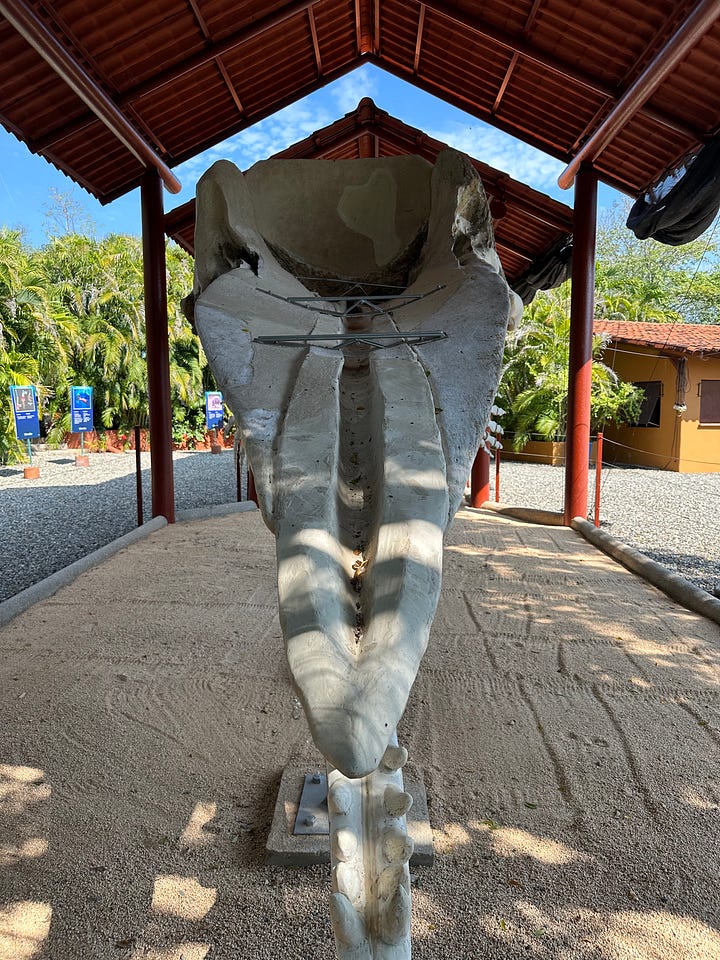
Before leaving, we climbed the observation tower (mirador), where we had views of the surroundings, helping us understand the area better. Unfortunately, we noticed too much construction activity in the vicinity. The bright green of the tropical forest is clear-cut and leveled for roads, homes, condos on the nearby beach…
Still, we left with the feeling of gratitude for the Refugio’s existence.
We returned to Jaime’s car in the shade, had a cold drink from his cooler, and got back on the road. He asked us what we thought about the center, and if we thought he should recommend it to others. He knew they hosted schools, but had no tourist ever ask him to take them there.
Yes, of course he should, we said, and told him about our experience and everything we saw - and why we found it interesting.
The ruins of Xihuacan weren’t far from there, so we didn’t make a detour for lunch. Food could wait when we were in exploring mode.
Midday might not be the best time to visit Xihuacan, but if that’s when we got there, it was as good of a time as any. At least in the winter. A bit on the warm side, we still found plenty of shade to walk around.
As archaeological sites in Mexico go, this is a small site, excavated recently, between 2007 and 2010.
The museum holds several artifacts that offer an insight into the ancient city of Xihuacan that flourished between 200 and 800 AD. However, the ruins span from the Pre-Classic to Post-Classic periods of Mesoamerican chronology.
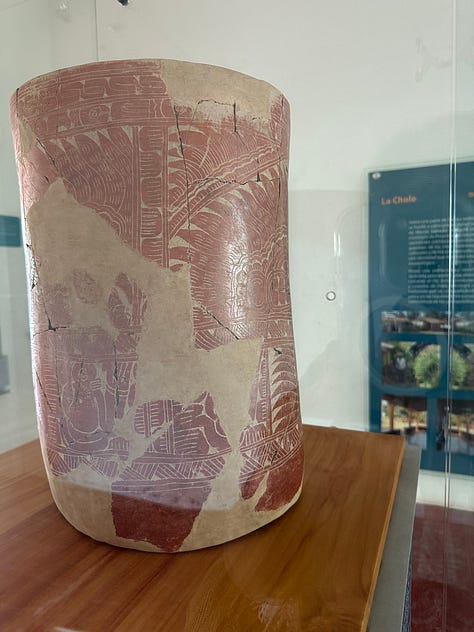
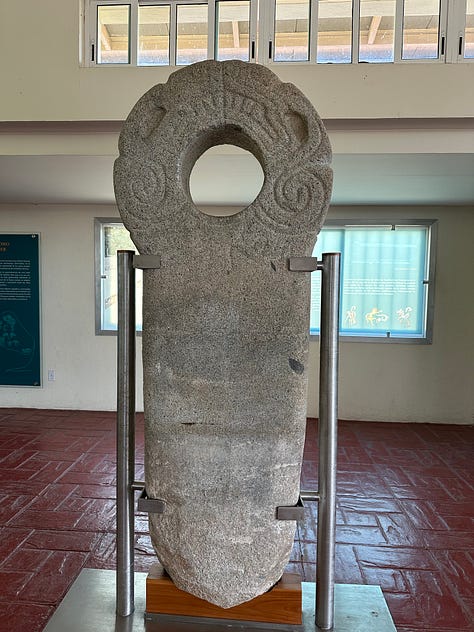
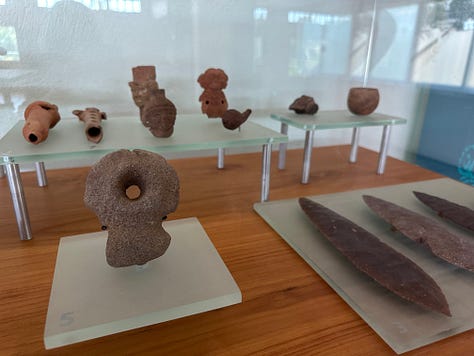
We walked from the museum to the ball court and the ceremonial center.
The ball court was one of the largest we have seen. Not Chichen Itza-size large, but still impressive. However, we could not walk through it, like we are used to doing so in other archaeological sites.
After a quick view of it, we moved on to the actual excavated site of the ancient city. The first - and most impressive sight was a wide pyramid-base.
We couldn’t climb it on its stairway, but a trail on the side led to its top, where we found several structures.


Besides the one trail, we couldn’t find much else to explore, but I remembered our first time in Ek Balam, when it was not much more than a few mounds, compared to now, so I think in the future there might be more to see at Xihuacan as well. Even the ball court is only partially excavated, and I read about a mound that is a pyramid underneath. Maybe worth a revisit in a decade or so.
Walking back towards the museum, Jaime met us halfway on the road, thinking it might have been too hot for us to walk.
Yes, it felt good to be back in the air-conditioned car, but when he asked us if we were too hot, I answered “we’ve been hotter”, and told him about some of our experiences with heat and humidity exploring Maya ruins all over Mexico, Guatemala, and Belize.
We were on our way back to the hotel.
It was way past lunchtime, and most of the restaurants were closed. They would reopen later for dinner. When we talked about food and places we could eat, Jaime asked us if we liked chicken. When we said yes, he told us he could stop at a restaurant that would be open if we wanted him to.
Of course we said yes.
So, we stopped at a local palapa-covered barbacoa on the side of the road in his village.
We walked in ahead of him while he locked the car. We sat down and Jeff asked for the menu.
“No menu,” was the answer. “We only make chicken. Roasted.”
“You can choose what part of the chicken you want.”
By then, Jaime joined us, and we all ordered.
It was the best chicken we had on the trip - and mostly everywhere -, and one of the best meals on the trip. Jaime told us about the owners, while we kept getting hot-from-the-oven tortillas to go with our meals as the owner lady was making them.
Besides the great meal, we felt we landed in the middle of a family, with their two dogs wandering around us, and two ladies making us food. It all reminded me of another time in Mexico, in the Lacandon jungle, when two Maya ladies prepared us a chicken dinner.
We spent some time enjoying not only the food but also the company before leaving the ladies.
But we had one more request, now that we knew Jaime well enough. He was going to take us to a Panaderia (bakery), so we could stock up on Mexican pastries for the next few days.
We drove through his town, through side streets and dirt roads, until he stopped in front of someone’s house.
“We’re here.”
I thought we were behind the actual store. Which might have been true. We followed Jaime in someone’s backyard, where they had a case filled with a variety of breads and pastries. I finally understood what he was telling us earlier. Namely, that the actual store was closed this late in the day, but they would still sell all their leftovers from the day. What we didn’t realize was that we would stop at the baker’s house for them.
The baker told us he made all his pastries and breads every morning at four. The only day he was not baking was Sunday, his fishing day. He even showed us photos of his boat and the fish he caught - some pretty large ones.
“Do you sell the fish you catch, too?” asked Jeff.
He laughed.
“No, that’s for me and my family. But mostly I fish because it’s fun.”
We left with a bag full of baked treats.
We got back to the hotel close to dinnertime. Needless to say, after the chicken meal we had, we needed no more food - except some of the sweet breads we picked up from the baker’s house.





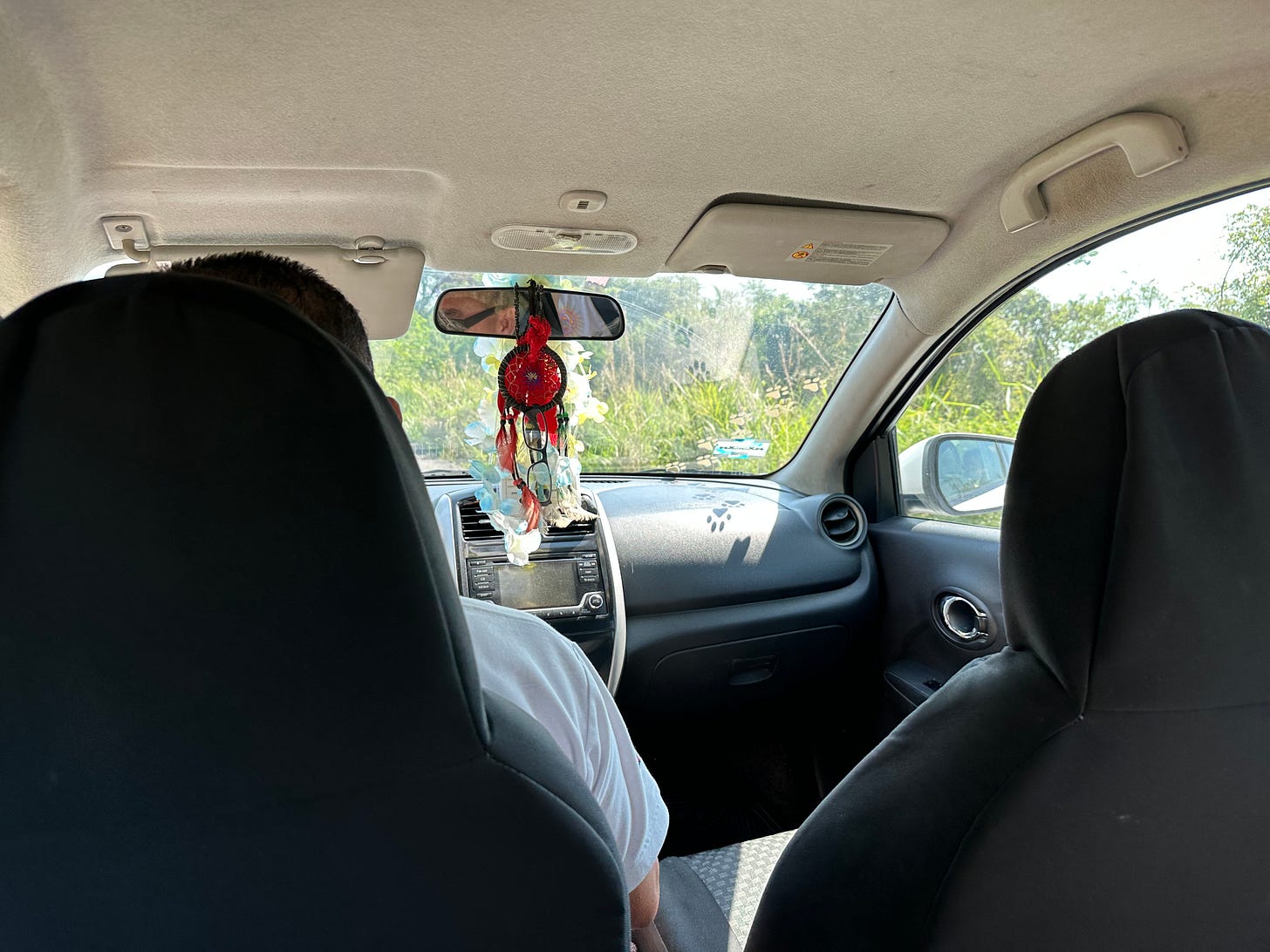






Thank you for the restack, @Jeanine Kitchel. Much appreciated :)
There's something special about hearing stories from a local's life. I love those moments. Such a unique insight and perspective. Thanks for the read!